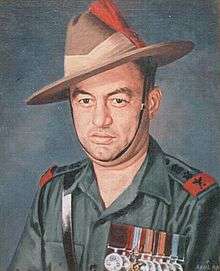Dhan Singh Thapa
| Lieutenant Colonel Dhan Singh Thapa PVC | |
|---|---|
 | |
| Born |
June 10, 1928 Shimla, Himachal Pradesh |
| Died | September 5, 2005 (aged 77) |
| Allegiance |
|
| Service/branch |
|
| Years of service | 1949-1975 |
| Rank |
|
| Unit | 1/8 Gorkha Rifles |
| Battles/wars | Sino-Indian War |
| Awards |
|
Lieutenant-Colonel Dhan Singh Thapa PVC (Nepali: मेजर धन सिंह थापा) (June 10, 1928 – September 5, 2005) was an Indian Army major in 1st Battalion, 8th Gorkha Rifles Regiment. He was awarded the Param Vir Chakra, India's highest military decoration.
Biography
Dhan Singh Thapa was born to P. S. Thapa at Shimla, Himachal Pradesh from Nepali parents. He was commissioned into the 8th Gurkha Rifles on 28 August 1949.
He was involved in a major action at Ladakh during the Sino-Indian War. The Sirijap valley, north of Pangong Lake in Ladakh, was considered vital for the defence of Chushul airfield. The 1/8 Gurkha Rifles had outposts there to thwart any Chinese encroachment in the area. One of these outposts named Sirijap-1 was held by a platoon of 'C' Company under the command of Major Thapa when the Chinese attacked on 20 October 1962.
At 06:00 on 20 October 1962, the Chinese opened a barrage of artillery and mortar fire over Sirijap-1 post. The shelling continued till 08:30 and the whole area was set ablaze. Some shells fell on the command post and damaged the wireless set. This put the post out of communication. The Chinese then attacked in overwhelming numbers. Major Thapa and his men repulsed the attack, inflicting heavy casualties. The Chinese mounted another attack in greater numbers after shelling the area with artillery and mortar fire.
Major Thapa once again repulsed the attack, inflicting heavy losses on the Chinese. A short while later, a third Chinese attack included tanks in support of the infantry. The defenders were weakened by the casualties suffered in earlier attacks, but held out while the ammunition lasted. When the Chinese finally overran the post, Major Thapa jumped out of his trench and killed many intruders in hand-to-hand fighting. He was eventually overpowered and captured. He became major after the war.
For his gallant act, Major Dhan Singh Thapa was honoured with the highest wartime gallantry medal, the Param Vir Chakra. He was believed to have been killed in this engagement, and the original citation reflects this.
He was later discovered to have been taken prisoner and after his release from the POW camp, he resumed his military career. He retired as Lieutenant-Colonel.
Citation
The Param Vir Chakra citation on the Official Indian Army Website reads as follows:
CITATION
MAJOR DHAN SINGH THAPA
1/8 GORKHA RIFLES (IC-7990)Major Dhan Singh Thapa was in command of a forward post in Ladakh. On 20 October it was attacked by the Chinese in overwhelming strength after being subjected to intensive artillery and mortar bombardment. Under his gallant command, the greatly outnumbered post repulsed the attack, inflicting heavy casualties on the aggressors. The enemy attacked again in greater numbers after heavy shelling by artillery and mortar fire Under the leadership of Major Thapa, his men repulsed this attack also with heavy losses to the enemy.
The Chinese attacked for the third time, now with tanks to support the infantry. The post had already suffered large numbers of casualties in the earlier two attacks. Though considerably reduced in number it held out to the last. When it was finally overrun by overwhelming numbers of the enemy, Major Thapa got out of his trench and killed several of the enemy in hand-to-hand fighting before he was finally overpowered by Chinese soldiers.
Major Thapa’s cool courage, conspicuous fighting qualities and leadership were in the highest traditions of our Army.[1]
Other Glorifications
The Shipping Corporation of India honoured the valor of this man by naming one of their ships as Major Dhan Singh Thapa PVC.
References
- ↑ The Param Vir Chakra Winners (PVC), Official Website of the Indian Army, retrieved 28 August 2014